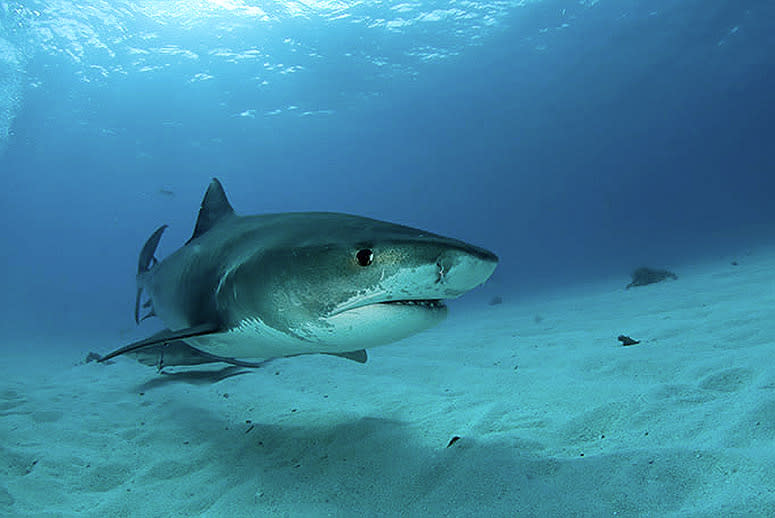Scientists Use Ultrasound to Find a Shark 'Maternity Ward' in the Bahamas

Something strange is going on with the sharks at Tiger Beach in the Bahamas. To understand it, scientists turned to new technologies that could transform the sometimes-lethal business of shark research into a less deadly pursuit.
Tiger Beach is known for its unusually large population of tiger sharks, around which a popular diving tourism industry has developed.
“Any given day, you can go diving with 10 to 15 extremely large tiger sharks,” said Neil Hammerschlag, shark researcher with the University of Miami’s Rosenstiel School of Marine and Atmospheric Science.
Hammerschlag has been diving off Tiger Beach for several years, and he noticed something odd about the sharks there. Sharks tend to segregate by size for much of the year, but the tiger sharks off Tiger Beach range from adults to juveniles.
“Most of them are female,” he added. That wasn’t all. A lot of them were obviously pregnant, with the equivalent of baby bumps on their undersides.
RELATED: Fishing Fleets Are Targeting Sharks Where They’re Most Vulnerable
Hammerschlag and his research partners set out to study this abnormal population, but they wanted to try something different. The typical technique for studying shark reproduction is to “sacrifice” the animal and study it postmortem.
Instead, Hammerschlag and James Sulikowski of the University of New England’s Department of Marine Science set out to develop a suite of noninvasive techniques, a process that took years.
“In the beginning, we started off just taking blood,” Hammerschlag said. While it didn’t kill the sharks, the tests showed very little differences between pregnant and immature sharks, and they weren’t very informative, he said.
In 2011, they tried something different: an ultrasound machine, the same device expectant mothers find in an ob-gyn’s office. The first attempts didn’t provide clear enough images, but work with a newer device a few years later yielded high-resolution images and a mother lode of data about the pregnant sharks’ pups and reproductive systems.
The results were published last month in the journal Aquatic Biology.
“I think a lot of people have been waiting for this,” Hammerschlag said. “In 2011, James and I published a paper saying we need to come up with these nonlethal alternatives. People at the time said the tech’s not out there. When this study came up we wanted to prove it for ourselves. It can be done.”
The study also documents how steroid hormones from shark blood can also be used to reveal pregnancy or sexual maturity.
“What we’ve been able to do is use a combination of these techniques, so if someone doesn’t have an ultrasound and they can just grab a blood sample, they can still get useful information from it,” said Sulikowski.
Costs remain an issue—ultrasound machines run tens of thousands of dollars each—but Sulikowski called the new technology an “awesome” advance for field research.
Now that Tiger Beach has been revealed as a year-round sanctuary for pregnant sharks, the next step is to learn more about why that is the case.
Hammerschlag said scientists still don’t know where the sharks are mating, giving birth, or feeding. The ultrasounds could help answer some of these mysteries, perhaps most notably by revealing the size of a pregnant shark’s pup in utero. Based on size, researchers can estimate roughly when they expect the mother shark to give birth.
By using satellite tracking, researchers can then figure out where the sharks are going to give birth. That information can help set fishing policies and protect pregnant or recently born sharks if they venture outside Tiger Beach, where shark fishing was banned in 2011.
Take the Pledge: Save a Shark: Say No to Finning
Related stories on TakePart:
• Fishing Fleets Are Targeting Sharks Where They’re Most Vulnerable
• Forget Sharks—in L.A., Beachgoers Better Watch Out for Tampons and Condoms
• How to Save Sharks From Extinction
Original article from TakePart

